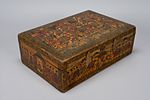Box
About this object
History of use
Beginning in the 18th and 19th centuries in the Zand and Qajar Periods artists began painting boxes, pen boxes, mirror cases, caskets and apothecary boxes in the traditional miniature painting style of the past. Characteristics of this style are; drawing the figures and landscape then infill painting; lack of perspective and spatial depth; confining the scene to a narrow foreground. Decorations are abstract at folds; spirals and arabesques in autonomous spaces; vegetal and floral abstract designs used; decorated bands around the edges. The major influences are from Arabian manuscripts, Mesopotamian traditions, Byzantine art as well as Chinese and Indian art styles.
Cultural context
Miniature painting.
Physical description
Wooden box with painted paper glued to exterior then covered with varnish. Bottom has green paper. Around the edges is a gold, black and red floral design band. Top has battle scene of men on horseback. The front and back sides have an image of a procession of men in the desert with hills, grass and background of houses and trees. The ends show a ruler sitting in a temple accompanied by ten attendants in tall black hats. All images are drawn flat. The men’s dress is simple, varying from long robes to short tunics and long boots. The men are shaved, bearded or mustached. Inside the box is lined with paper consisting of blue, silver and white floral print. Two black cloth straps hold the lid and are attached in place by thumb tacks. Adhered with tape are two handwritten notes on Darius and Horus.
Materials
Wood Paint Lacquer Paper Metal Cotton fibre Synthetic adhesive
